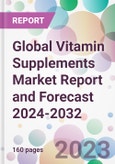The global vitamin supplements market size was valued USD 54.8 billion in 2023, driven by increasing health consciousness, aging population, nutrient deficiency has led to market growth across the globe. The market size is anticipated to grow at a CAGR of 7.2% during the forecast period of 2024-2032 to achieve a value of USD 102.5 billion by 2032.
Vitamin supplements are available in different forms, such as capsules, tablets, soft gels, liquids, and gummies, offering convenience and flexibility to consumers. They are commonly used to address potential nutrient deficiencies, enhance dietary intake, and support specific health goals. While a balanced diet remains the primary source of vitamins, supplements can help fill gaps that might arise due to various factors such as dietary restrictions, lifestyle choices, or specific health conditions.
Vitamin Supplements: Introduction
Vitamin supplements play a vital role in supporting optimal health by providing essential nutrients that our bodies need for proper functioning. These supplements contain various vitamins, which are essential organic compounds that contribute to various physiological processes, such as immune function, energy metabolism, and overall well-being.Vitamin supplements are available in different forms, such as capsules, tablets, soft gels, liquids, and gummies, offering convenience and flexibility to consumers. They are commonly used to address potential nutrient deficiencies, enhance dietary intake, and support specific health goals. While a balanced diet remains the primary source of vitamins, supplements can help fill gaps that might arise due to various factors such as dietary restrictions, lifestyle choices, or specific health conditions.
Key Trends in the Global Vitamin Supplements Market
- Growing Health and Wellness Awareness: Increasing awareness about the importance of maintaining good health and preventing illnesses has been a significant driver for the vitamin supplements market. Consumers are becoming more proactive in managing their health and are seeking dietary supplements as a means to complement their wellness routines.
- Demand for Personalized Nutrition: Personalized nutrition has gained traction, and this trend extends to the vitamin supplements sector. Consumers are seeking supplements tailored to their individual needs, health goals, and genetic profiles. Companies are leveraging technology to offer personalized recommendations and formulations.
- E-Commerce and Direct-to-Consumer Sales: The rise of e-commerce and direct-to-consumer (DTC) sales has transformed the distribution landscape for vitamin supplements. Consumers are increasingly purchasing supplements online, enabling them to access a wide range of products and brands conveniently.
- Clean Label and Transparency: Consumers are demanding greater transparency and clean label products in the supplements market. They want to know what ingredients are in the supplements they are consuming, and they are seeking products with minimal additives, allergens, and artificial ingredients.
Global Vitamin Supplements Market Segmentation
The market can be categorised into type, form, source, distribution channel, end user and region.Market Breakup by Type
- Vitamin A
- Vitamin B
- Vitamin C
- Vitamin D
- Vitamin E
- Vitamin K
- Multivitamin
- Others
Market Breakup by Form
- Tablet
- Powder
- Capsule
- Gummies
- Others
Market Breakup by Source
- Plant Source
- Animal Source
- Others
Market Breakup by Distribution Channel
- Supermarkets and Hypermarkets
- Retail Pharmacy
- Online Sales
- Others
Market Breakup by End User
- Pediatrics
- Adults
- Geriatrics
Market Breakup by Region
- North America
- Europe
- Asia Pacific
- Latin America
- Middle East and Africa
Global Vitamin Supplements Market Overview
The global vitamin supplements market encompasses a wide range of products designed to provide essential vitamins that may be lacking in daily diets. These supplements aim to support overall health and well-being by addressing potential nutrient deficiencies and promoting optimal bodily functions. The market for vitamin supplements has experienced significant growth over the years, driven by factors such as increasing health consciousness, aging populations, and a growing focus on preventive healthcare. The market is characterized by a diverse range of products catering to various age groups, health goals, and lifestyles. As the demand for vitamin supplements continues to grow, manufacturers, healthcare professionals, and regulatory bodies are collectively working to ensure that consumers have access to safe, high-quality products that contribute to their overall health and well-being.Key Players in the Global Vitamin Supplements Market
The key features of the market report include patent analysis, grants analysis, clinical trials analysis, funding and investment analysis, partnerships, and collaborations analysis by the leading key players.The major companies in global vitamin supplements market are as follows:
- Glanbia PLC
- Bayer AG
- Amway Corp.
- NOW Foods
- The Nature's Bounty Co.
- GlaxoSmithKline plc.
- Good Health New Zealand
- Nature's Sunshine Products, Inc.
- Abbott
- Herbalife Nutrition
- American Health, Inc.
- Pharmavite
- RBK Nutraceuticals Pvt Ltd.
Table of Contents
1 Preface
3 Global Vitamin Supplements Market Overview
4 Global Vitamin Supplements Market Landscape
5 Global Vitamin Supplements Market Dynamics
6 Global Vitamin Supplements Market Segmentation
7 North America Vitamin Supplements Market
8 Europe Vitamin Supplements Market
9 Asia Pacific Vitamin Supplements Market
10 Latin America Vitamin Supplements Market
11 Middle East and Africa Vitamin Supplements Market
12 Patent Analysis
13 Grants Analysis
14 Funding Analysis
15 Partnership and Collaborations Analysis
16 Regulatory Framework
17 Supplier Landscape
18 Global Vitamin Supplements Market - Distribution Model (Additional Insight)
20 Company Competitiveness Analysis (Additional Insight)
21 Payment Methods (Additional Insight)
Companies Mentioned
- Glanbia PLC
- Bayer AG
- Amway Corp.
- NOW Foods
- The Nature's Bounty Co.
- GlaxoSmithKline plc.
- Good Health New Zealand
- Nature's Sunshine Products Inc.
- Abbott
- Herbalife Nutrition
- American Health Inc.
- Pharmavite
- RBK Nutraceuticals Pvt Ltd.
Methodology

LOADING...








